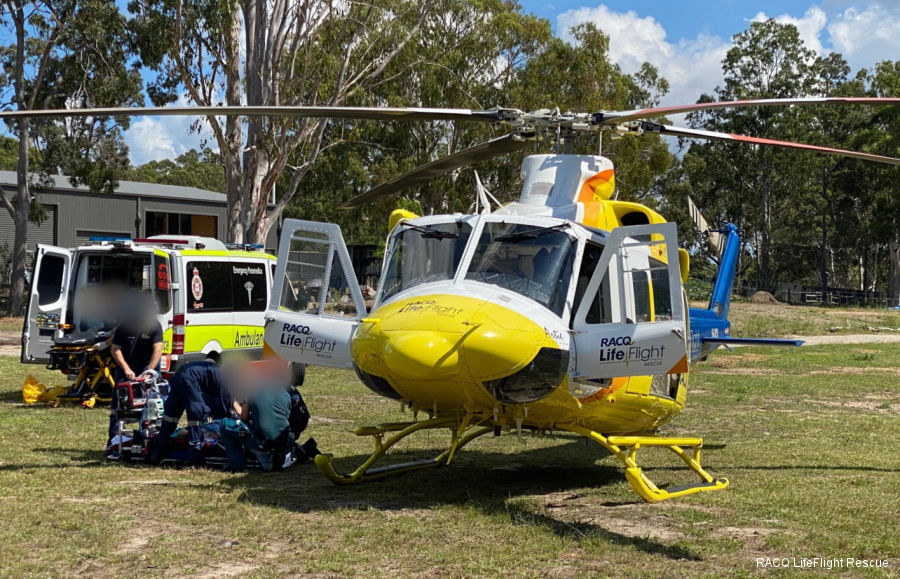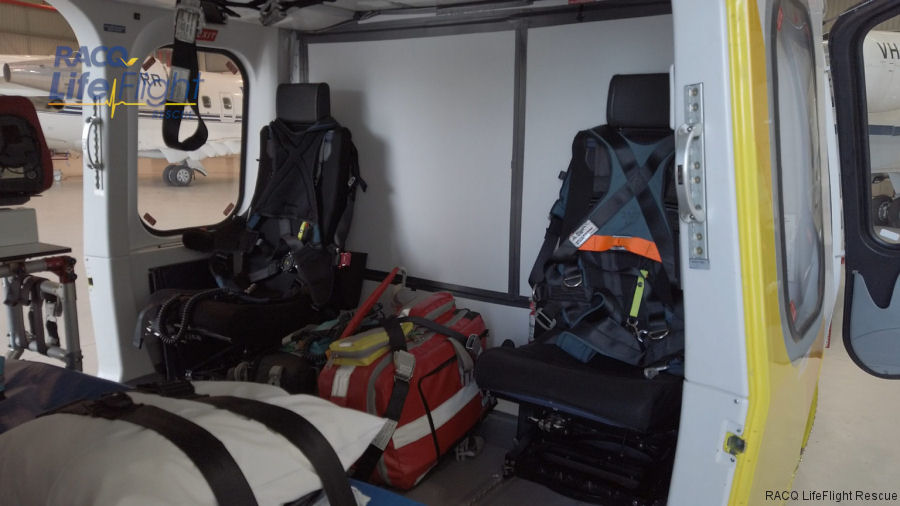
RACQ CQ Rescue, April 21, 2020 - It’s a highly infectious virus, with a vaccine yet to be found, but RACQ LifeFlight Rescue will continue to ramp up its safety measures, to ensure its community helicopters remain on the frontline to combat COVID-19.
“The way we think about our jobs now is different, because every patient could potentially be a COVID-19 patient, so the way we do business now has changed dramatically,” Chief Pilot Dave Bashir said.
From full body gowns, goggles and boots, to face masks and head protection, the Personal Protection Equipment (PPE) worn by RACQ LifeFlight Rescue’s doctors, nurses, paramedics and those who fly the choppers, is unlike anything the organisation has had to implement before.
“I’ve been flying helicopters since 1990 and I’ve been with RACQ LifeFlight Rescue for the past 15 years,” Mr Bashir said.
“Every now and then we get patients who have a disease or viral infection that we have to wear masks for, but this is certainly the first time we’ve had to go to this extent.”
Unlike in a pressurised jet, airflow in a helicopter is recirculated – meaning the potential risk of contamination is higher.
“The challenge in transporting any patient with a highly infectious disease is that we have a restricted or confined space,” LifeFlight Chief Medical Officer Dr. Allan MacKillop said.
“We don’t have the luxury of having large areas around the patient to make ‘hot zones’ or ‘less infected zones’, every zone inside the helicopter is what we call a ‘hot zone’.”
To further ensure flight crews remain as safe as possible when working on the frontline, LifeFlight engineers have reinforced a protective screen, which separates the pilots from the medical crew and patient.
“Our AW139 helicopters in Brisbane and Toowoomba already have a screen that separates the pilot from the cabin and the patient, so we’ve reinforced that screen with further measures to essentially isolate cockpit from the cabin,” Dr. MacKillop said.
“On the Sunshine Coast and in Bundaberg, our Bell 412 helicopters are now fitted with these curtains, which essentially isolate the cockpit from the cabin.”
The LifeFlight Surat Gas Aeromedical Service AW139 helicopters, based in Toowoomba and Roma have also been installed with the same safety feature.
“RACQ LifeFlight Rescue is the only organisation in Australia which has managed to engineer something like this, in such a short time,” Dr. MacKillop said.
RACQ LifeFlight Rescue’s quick and effective innovations, in light of this pandemic, are being shared with aeromedical organisations both nationally and internationally and Dr. MacKillop says the organisation is learning from the experiences of others, too.
“We’ve got fantastic collaboration between the aeromedical providers,” Dr. MacKillop said.
“We’re speaking to our colleagues in Great Britain, the United States, Canada and throughout the rest of Australia at least three times a week, on an international teleconference where we share our solutions to these ever changing challenges.”
RACQ LifeFlight Rescue Critical Care Doctors, Flight Nurses, Paramedics, Air Ambulance and community helicopter crews have already assisted and successfully, safely transported a number of suspected and confirmed COVID-19 patients.
Over the coming months, RACQ LifeFlight Rescue will continue to work with Queensland Health and Retrieval Services Queensland, to manage demand for the service.
“We believe that our preparations are as good as they can be and we believe we will be able to manage any surge in requirement in transporting critically ill patients with COVID-19,” Dr. MacKillop said.
Protecting aeromedical teams isn’t only about their personal well-being, it also ensures they are healthy and available to respond to the many other types of missions, which are still being performed daily – attending emergency situations, undertaking rescues and transferring patients between hospitals.
“At this stage, RACQ LifeFlight Rescue has done everything possible to ensure the safety of our aircrew, medical teams and patients throughout this crisis,” said Dr MacKillop.
“The way we think about our jobs now is different, because every patient could potentially be a COVID-19 patient, so the way we do business now has changed dramatically,” Chief Pilot Dave Bashir said.
From full body gowns, goggles and boots, to face masks and head protection, the Personal Protection Equipment (PPE) worn by RACQ LifeFlight Rescue’s doctors, nurses, paramedics and those who fly the choppers, is unlike anything the organisation has had to implement before.
“I’ve been flying helicopters since 1990 and I’ve been with RACQ LifeFlight Rescue for the past 15 years,” Mr Bashir said.
“Every now and then we get patients who have a disease or viral infection that we have to wear masks for, but this is certainly the first time we’ve had to go to this extent.”
Unlike in a pressurised jet, airflow in a helicopter is recirculated – meaning the potential risk of contamination is higher.
“The challenge in transporting any patient with a highly infectious disease is that we have a restricted or confined space,” LifeFlight Chief Medical Officer Dr. Allan MacKillop said.
“We don’t have the luxury of having large areas around the patient to make ‘hot zones’ or ‘less infected zones’, every zone inside the helicopter is what we call a ‘hot zone’.”
To further ensure flight crews remain as safe as possible when working on the frontline, LifeFlight engineers have reinforced a protective screen, which separates the pilots from the medical crew and patient.
“Our AW139 helicopters in Brisbane and Toowoomba already have a screen that separates the pilot from the cabin and the patient, so we’ve reinforced that screen with further measures to essentially isolate cockpit from the cabin,” Dr. MacKillop said.
“On the Sunshine Coast and in Bundaberg, our Bell 412 helicopters are now fitted with these curtains, which essentially isolate the cockpit from the cabin.”
The LifeFlight Surat Gas Aeromedical Service AW139 helicopters, based in Toowoomba and Roma have also been installed with the same safety feature.
“RACQ LifeFlight Rescue is the only organisation in Australia which has managed to engineer something like this, in such a short time,” Dr. MacKillop said.
RACQ LifeFlight Rescue’s quick and effective innovations, in light of this pandemic, are being shared with aeromedical organisations both nationally and internationally and Dr. MacKillop says the organisation is learning from the experiences of others, too.
“We’ve got fantastic collaboration between the aeromedical providers,” Dr. MacKillop said.
“We’re speaking to our colleagues in Great Britain, the United States, Canada and throughout the rest of Australia at least three times a week, on an international teleconference where we share our solutions to these ever changing challenges.”
RACQ LifeFlight Rescue Critical Care Doctors, Flight Nurses, Paramedics, Air Ambulance and community helicopter crews have already assisted and successfully, safely transported a number of suspected and confirmed COVID-19 patients.
Over the coming months, RACQ LifeFlight Rescue will continue to work with Queensland Health and Retrieval Services Queensland, to manage demand for the service.
“We believe that our preparations are as good as they can be and we believe we will be able to manage any surge in requirement in transporting critically ill patients with COVID-19,” Dr. MacKillop said.
Protecting aeromedical teams isn’t only about their personal well-being, it also ensures they are healthy and available to respond to the many other types of missions, which are still being performed daily – attending emergency situations, undertaking rescues and transferring patients between hospitals.
“At this stage, RACQ LifeFlight Rescue has done everything possible to ensure the safety of our aircrew, medical teams and patients throughout this crisis,” said Dr MacKillop.

See also |
List of Coronavirus outbreak




